 |
AIDS AND EQUIPMENT IN THE COVER PHOTO
The cover photo shows Raúl, a boy born with club feet, whose
story is told in Chapter 14 (page 97).
If you look closely at the photo, you will see examples of some of
the aids and equipment we explore in this book. These same items are
shown in the drawings below, together with the page numbers where
you can find them.

|
|
|
|
|
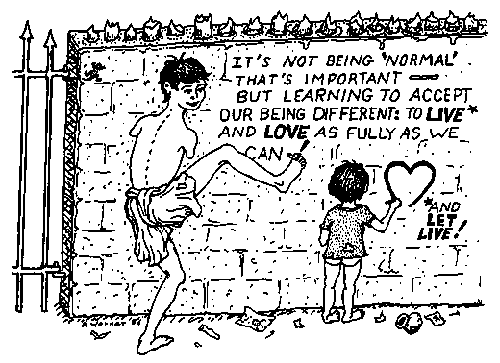
This book is dedicated to those people
everywhere who, because they are different,
are looked down upon or are not given
an equal chance...
and to my friends at PROJIMO
who continue to show us that persons
who are different can make a difference.
|
|
Many persons have helped with the creation of this book and
the innovative processes it describes.
Following are some of the most important contributors.
| First, heartfelt thanks go to the
rehabilitation team of PROJIMO (Program of
Rehabilitation Organized by Disabled Youth of Western
Mexico) without whose creativity, hard work, and caring
touch the substance for most of this book would not
exist. Of the PROJIMO team, those whose contributions
are portrayed on these pages include Conchita Lara, Mari
Picos, Marcelo Acevedo, Armando Nevárez, Inez León,
Cecilia Rodríguez, Rosa Salcido, Julio Peña, Martín
Pérez, María de Jesús Leyva, Jaime Torres, Irma Llavió,
Mario Carrasco Hernández, Miguel Zamora, and Marielos
Rosales. Local children and youth who have helped to
make equipment include Leopoldo Ribota, Martín Reyes
Millán, Ernesto Navarro, Manuella Campista, Dionicio
González, and Isidro González. Also, hearty thanks go
to the many disabled children, parents, and adults who
participated in the problem-solving process.
Deep thanks go to Kennett and Jean Westmacott of
People Potential in England for their emphasis on
an empowering approach that puts the disabled person and
family at the center of the problem-solving process.
This innovative "partnership approach," introduced to
the PROJIMO team, has provided much of the inspiration
for this book. And for stretching our imagination for
creative inventiveness, a strong vote of thanks goes to
Reinder van Tijen of Stichting Demotech, Design for
Self-Reliance.
Very special thanks for their essential contributions
go to visiting experts in different areas of
rehabilitation, therapy, and engineering who were
involved in designing and creating personalized
assistive equipment and in facilitating workshops -
especially to Ann Hallum, John Fago, Ralf Hotchkiss,
Oliver Bock, Michael Heinrich, Marybetts Sinclair, Jean
Anne Zollars, and Kennett Westmacott.
For providing stories and photos of her creation of
Appropriate Paper Technology aids for her daughter, Kim,
warm thanks go to Sigi Lester.
Contributors to lively writings in the book include
Oliver Bock, John Fago, and Gene Rodgers. Contributors
of ideas and designs for specific innovative
technologies include Monica Rook, Joep Verweij, and
Annemick van Boeijen.
For introducing the author to innovative technologies
in India, the author is grateful to San Yuenwah of
UN-ESCAP, and to Lourdes Canziani of CORDE for
information on new technologies in Brazil.
For specific outstanding photos in this book we thank
John Fago, Renée Burgard, Ralf Hotchkiss, Ann Hallum,
Kennett and Jean Westmacott, Sigi Lester, Lonny
Shavelson, Mari Picos, and Shahidul Haque for
SARPV-Bangladesh.
For help with drawings we thank Efraín Zamora,
Elizabeth Irwin, and Alicia (Tattie) Brelsford. (Most of
the photos and line drawings in this book were done by
David Werner.)
For help with scanning all photos and drawings and
integrating them into the text we thank Efraín Zamora,
whose tireless work was consistently outstanding. Thanks
for assistance with scanning also go to Merlin
Schlumberger, and to Liisa Turan for technical
assistance with Quark Express.
For technical assistance with photo preparation,
layout and design, formatting, computer
trouble-shooting, proofing, and a thousand odds and
ends, I am deeply grateful to Jason Weston.
For their extremely important critical feedback on a
draft of the book, I thank Ann Hallum, Kennett and Jean
Westmacott, Mike Miles, Laura Krefting, Johan Borg, Ralf
Hotchkiss, Pam Zinkin, and Sophie Levitt.
My deep appreciation goes to Renée Burgard for the
final editing of the book and fine-tuning of the layout.
Her artist's eye has done much to make this book more
attractive.
For help with editing, proofreading and/or technical
work, thanks go to Bruce Hobson, Trude Bock, Marianne
Schlumberger, Tinker Spar, Jason Weston, Dorothy Weston,
Edward J. Weston, Ted Weston, Tina Weston, and Lisa
Wright.
Special thanks go to the Thrasher Foundation, whose
assignment to PROJIMO of a 3-year grant for the
development of innovative technologies provided the
initial motivation for this book.
For the primary financial assistance for developing
Nothing About Us Without Us we are grateful to
the Norwegian International Disability Alliance, and
specifically to Harold Lundqvist and Pal Skogmo for
their trust in the venture and their encouragement. For
funding assistance for final publication of the book we
are deeply thankful to the Mulago Foundation, to the
Liliane Foundation Support Fund, and to Sti.
Kinderpostzegels in the Netherlands.
Finally, as always, my deep appreciation goes to
Gertrude (Trude) Bock, who has contributed her home and
her heart not only to making this and my earlier books a
success, but also to giving the hundreds of disabled
children whom she has cared for new hope and greater
opportunities.

|
|
|

This is an "idea book" about problem solving
- not a "cookbook" with precise instructions and
measurements for making pre-designed aids and equipment.
It is about thinking problems through
rather than just following instructions. Nevertheless,
you can use it as a reference book
concerning different disabilities, assistive devices,
and methods of problem solving.
The book is divided into an Introduction
and 6 Parts. We suggest you
start by reading the main Introduction. This
gives an overview of the book's purpose and content.
Each of the 6 Parts also has its own helpful
introduction. Page-edges of these introductions are
marked with short black lines. The book's index has
page-edges marked with a long black line.
================
TO FIND WHAT YOU ARE LOOKING FOR IN THE BOOK, YOU
CAN USE:
 | The list of
CONTENTS at
the beginning of the book.
This lists all the Parts and Chapters in the order
that they appear in the book, and it gives page
numbers.
|
 | The INDEX at the end of the book
(the pages with the whole outer edge black, starting
on page 345.
This lists in alphabetical order (a,
b, c, d, and so on) all the topics or names that you
may want to look up.
The Index is coded in this way:
 | Names of persons who appear in the stories are
listed in the Index alphabetically by their first
name, like this: CARINA; EDGAR; MARI PlCOS. |
 | Names of assistive devices and technologies
appear like this: braces; communication
boards; wheelchairs. |
 | Names of ditferent disabilities or problems are
listed like this: blindness; speech
problems; spinal-cord injury. |
 | All other entries are listed in ordinary
letters, iike this: Child-to-Child activities;
India; land mines; women's rights. |
|
If you cannot find what you are looking for,
look under a similar name.
For example, if you don't find infantile
paralysis, look under polio or
paralysis.
================
KEY PLAYERS. Most of the stories in
this book come from PROJIMO, a community based
rehabilitation program run by disabled villagers in
Mexico. After the main Introduction to the book, there
is a brief description of some of the members of
the PROJIMO team, including MARl,
CONCHITA, and MARCELO, whom
you will meet often in the stories.
For further information on
innovative technologies, or on groups to contact, see
the two resource lists at the end of the book (just
before the Index):
 | Resource List I : Organizations and
Programs, page 341
; |
 | Resource List 2: Reading and Teaching
Materials page 343. |
Please note:
The first 4 Parts of this book focus on creating aids
and equipment.
The last 2 Parts look at innovative approaches to the
integration and participation of disabled persons
in the home, community, school, and work place*.
_____________________
*Because this book is organized around individuals
and their needs rather than by kinds of disability or
assistive devices, to find information on a particular
disability or device - such as cerebral palsy,
or special seats - you may need to refer to
several chapters or even Parts of the book. For this you
will find the Index especially helpful.
|
|
|
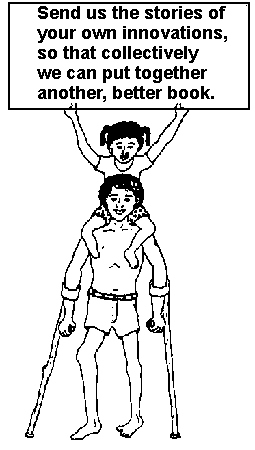
We hope that this book is only the beginning of an
ongoing, still very incomplete process of sharing
helpful ideas. It tells personal stories of the search
for solutions by folks who mostly live in one small
corner of the world (western Mexico). And it focuses
mainly on physical disabilities, because that is the
area in which PROJIMO (the village program that gave
life to this book) happens to have the most experience.
Likewise, the stories told here and the solutions
found may not be the most instructive or appropriate
(even locally). We work with what we have, within our
limitations. However, it is better to share
blemished fruit than none at all.
We imagine that many of you - the readers of this
book - are disabled, or that you relate to or work with
persons with a disability. Many of you have your own
great stories of how you have searched for and
discovered solutions. On reading this book, perhaps some
of you will get ideas for more useful innovations than
the ones we describe. (We hope the book will
inspire you to try out your own clever ideas - not just
ours!)
Among disabled persons around the world, their
families, friends, and those who work with them, there
is a wealth of exciting ideas, rich experiences, and
innovative solutions (or partial solutions).
This book just touches the surface of what is possible.
So, here is our invitation:
We hope that you, the readers of this book,
will send us your own stories and experiences.
Let us hear from you about innovations, gadgets,
"appropriate technologies," and "easier ways of doing
things" - discoveries that you would like to share with
others. If possible, include drawings, photos, or both.
(See page 340, on
Suggestions for Effective Information-Sharing in Print.)
There are 3 ways in which we may be able to share
your contributions:
 | We can share them with the PROJIMO team of
disabled village rehabilitation workers. Your findings
may trigger their imaginations to
experiment with new ideas, designs and possibilities,
adapting them to their own local resources and
reality. |
 | We hope to include some stories in our
Newsletter from the Sierra Madre, which
reaches health and disability workers in 130
countries. (Write to us at HealthWrights if you might
like to subscribe.) |
 | If we get enough good ideas, we may put together
another book similar to this one, but hopefully even
more useful because it will be more of a world-wide,
cooperative venture. |
In describing your innovations, please tell
enough about the local situation and the people involved
to make the stories personal and heart-warming. Try to
show that technology should serve people,
rather than people serving technology.
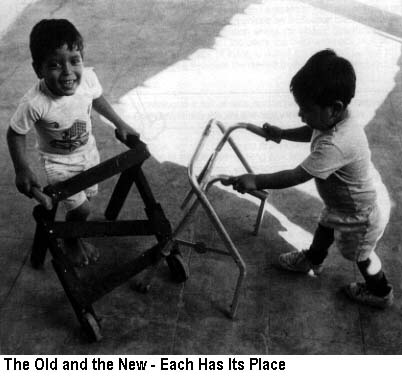
|
|
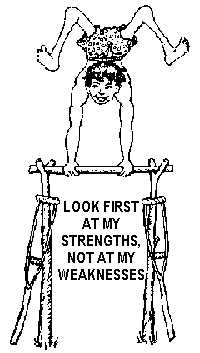
|
| The wooden
walker, with its bigger wheels, rolls better on
rough ground than the "modern" aluminum walker.
The wooden front wheels act as brakes when the
child puts his weight on them to step forward -
a feature the aluminum walker lacks (see
page 53). Also,
because the wooden walker is heavier it gives
more stability to the child with unsure balance. |
|
|
|
Nothing About Us Without Us
Developing Innovative Technologies
For, By and With Disabled Persons
by David WernerLibrary of Congress Cataloging in
Publication Data
Includes Index
- Medicine, Popular - Handbooks, manuals, etc.
- Rehabilitation - Handbooks, manuals, etc.
- Community Health Aids - Handbooks, manuals, etc.
- Appropriate Technology - Handbooks, manuals, etc.
Library of Congress Catalog Card No:97-073594
Werner, David, 1934-
- Nothing About Us Without Us: Developing Innovative
Technologies
- For, By and With Disabled Persons / David Werner
- 360 pages
- ISBN 0-9655585-3-3
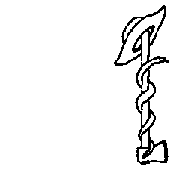
|
Published by
HealthWrights
Workgroup for People's Health and Rights
Post Office Box 1344
Palo Alto, CA 94302, USACopyright 1998 by David
Werner |
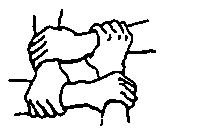
|
Any parts of this book, including the illustrations,
may be copied, reproduced, or adapted to meet local
needs, without permission from the author or publisher,
provided the parts reproduced are distributed
free or at cost, not for profit. For any
reproduction with commercial ends, permission must first
be obtained from the author or HealthWrights. The author
would appreciate being sent a copy of any materials in
which text or pictures have been used.
Note to those considering translation:
To avoid duplication of efforts, and for suggestions
about adapting the ideas and information in this book,
before beginning any translation please contact the
author or HealthWrights.
Printed in the United States of America on recycled
paper
|

Nothing About Us Without Us is a book
of true stories about people's creative search for
solutions. It is an idea book, written for disabled
persons and their relatives, friends, helpers, and
anyone who favors A Society for All.
The book differs from many appropriate technology
manuals in that it puts emphasis not so much on the
end-products - or things - as on the
persons involved and the collective process
of search and discovery.
Nothing About Us has been written as
companion to David Werner's earlier book, Disabled
Village Children, now used in Community Based
Rehabilitation programs worldwide.
The book explores the development of innovative aids
and equipment that can be made at low cost at home or in
a small community workshop. Yet it also considers how to
achieve fuller integration of disabled people into
society: ways to help communities look at disabled
persons' strengths, not their weaknesses. Examples of
Child-to-Child activities show how disabled and
non-disabled children can work, play and learn together,
to enrich one another's lives.
This is not a "cookbook" with precise instructions
for making pre-designed devices. Rather it is about
thinking through challenges and possibilities. Solutions
tend to be best when the disabled person is a partner
and equal in the problem-solving process. The goal of
this book is to spark the reader's imagination: to
stimulate a spirit of adventure!
The book is based on years of collaborative work by
David Werner and the disabled villagers who created and
run PROJIMO, an innovative rehabilitation program in
rural Mexico. However, it draws on experiences from many
lands.
Over 800 line drawings and 600 photos help make the
information clear for those with little formal
education.
In the words of community rehabilitation pioneer,
Mike Miles, "This is primarily a book about
learning to think." |
|